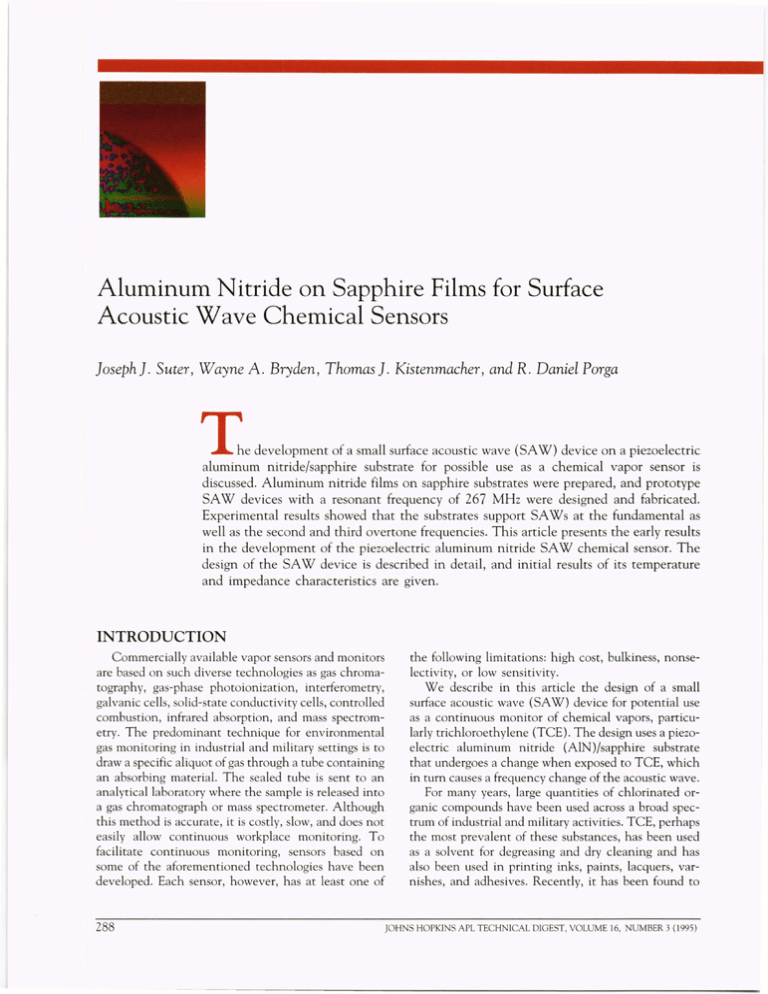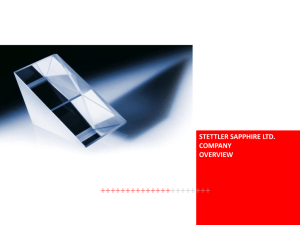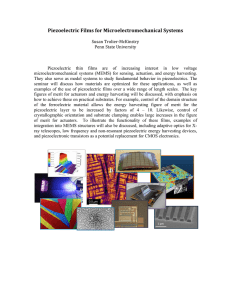Aluminum Nitride on Sapphire Films for Surface J.
advertisement

Aluminum Nitride on Sapphire Films for Surface
Acoustic Wave Chemical Sensors
JosephJ. Suter, Wayne A. Bryden, Thomas J. Kistenmacher, and R. Daniel Parga
L
e development of a small surface acoustic wave (SAW) device on a piezoelectric
aluminum nitride/sapphire substrate for possible use as a chemical vapor sensor is
discussed. Aluminum nitride films on sapphire substrates were prepared, and prototype
SAW devices with a resonant frequency of 267 MHz were designed and fabricated.
Experimental results showed that the substrates support SAWs at the fundamental as
well as the second and third overtone frequencies. This article presents the early results
in the development of the piezoelectric aluminum nitride SAW chemical sensor. The
design of the SAW device is described in detail, and initial results of its temperature
and impedance characteristics are given.
INTRODUCTION
Commercially available vapor sensors and monitors
are based on such diverse technologies as gas chromatography, gas-phase photo ionization, interferometry,
galvanic cells, solid-state conductivity cells, controlled
combustion, infrared absorption, and mass spectrometry. The predominant technique for environmental
gas monitoring in industrial and military settings is to
draw a specific aliquot of gas through a tube containing
an absorbing material. The sealed tube is sent to an
analytical laboratory where the sample is released into
a gas chromatograph or mass spectrometer. Although
this method is accurate, it is costly, slow, and does not
easily allow continuous workplace monitoring. To
facilitate continuous monitoring, sensors based on
some of the aforementioned technologies have been
developed. Each sensor, however, has at least one of
288
the following limitations: high cost, bulkiness, nonselectivity, or low sensitivity.
We describe in this article the design of a small
surface acoustic wave (SAW) device for potential use
as a continuous monitor of chemical vapors, particularly trichloroethylene (TCE). The design uses a piezoelectric aluminum nitride (AlN)/sapphire substrate
that undergoes a change when exposed to TCE, which
in turn causes a frequency change of the acoustic wave.
For many years, large quantities of chlorinated organic compounds have been used across a broad spectrum of industrial and military activities. TCE, perhaps
the most prevalent of these substances, has been used
as a solvent for degreasing and dry cleaning and has
also been used in printing inks, paints, lacquers, varnishes, and adhesives. Recently, it has been found to
JOHNS HOPKINS APL TECHNICAL DIGEST, VOLUME 16, NUMBER 3 (1995)
be both carcinogenic and mutagenic in animal tests
and hence is regulated by the Occupational Safety and
Health Administration.
Despite the known occupational exposure hazards,
TCE is still widely used instead of other less harmful
solvents. Furthermore, much TCE-bearing waste is
improperly disposed of, generally by dumping in industrial and commercial landfills. Chemicals such as TCE
are known to leach out of the storage location and into
the groundwater surrounding the landfill. The mobility of chemicals from a landfill into groundwater has
caused such environmental disasters as the Love Canal
incident in upstate New York. Therefore, early detection of TCE in the environment is critical. The SAW
chemical sensor we describe in this article is inexpensive and designed specifically to measure small
amounts of TCE in the environment. By measuring
frequency shifts introduced into the SA W device
through the interaction of the TCE and the AlN film,
this device should be able to detect TCE vapors to
levels smaller than 1 ppm.
SURF ACE ACOUSTIC WAVE
DEVICES
SAW devices make use of the piezoelectric effect
exhibited by certain materials. 1 When an electric field
is applied to a piezoelectric material, a mechanical
strain is produced and vice versa. The relationship
between electric field and strain is described by the
coupling coefficient, which is a function of material
and frequency. Two commonly used piezoelectric substrates are quartz and lithium niobate (LiNb03 ), with
coupling coefficients of about 0.00116 and 0.056, respectively. Lately, AlN has been used as a piezoelectric
material for the fabrication of SAW devices.
In SAW devices, an electric field is applied to the
substrate by means of an interdigital transducer. In its
simplest form, the transducer consists of many parallel
metal electrodes called fingers, which are alternately
connected together by bus bars as shown in Fig. 1. The
fingers are usually a thin film of aluminum between 500
and 10,000 A thick, many millimeters long, and a few
micrometers wide; the spacing between fingers equals
the width of the finger. Transducers are fabricated
using photolithographic techniques developed for
semiconductor technology.
When a time-varying voltage is applied to the bus
bars, a spatially and temporally periodic electric field is
generated within the transducer. This electric field in
turn produces periodic strain fields in the substrate.
Since quartz and LiNb03 are also elastic materials,
acoustic (mechanical) waves result. This process is most
efficient when the acoustic wavelength equals the finger pitch L; therefore, the finger width is related to the
operating frequency of the device and the wave velocity
Fingers
\
Surface
waves
generated
Bus bar
Surface
waves
generated
Bus bar
Figure 1. Schematic of the surface acoustic wave (SAW) device
(resonance frequency = 267 MHz) placed on an APL-designed
aluminum nitride substrate showing the interdigital transducers
and SAW pattern (L = finger pitch in micrometers).
in the substrate material. For example, a 100-MHz
device on quartz with a 3200-m/s wave velocity would
result in fingers (3200 m/s)/(lOO MHz)/4 = 8 Ilm wide.
Waves generated by the transducer propagate both
at the substrate surface and into the bulk material;
however, bulk waves are undesirable in a surface wave
device and typically are scattered by roughening the
bottom surface of the substrate. Because of the symmetrical nature of the transducer, surface waves are emitted
from both apertures; hence, these transducers are called
bidirectional. The waves in one direction are not
needed and are absorbed by applying a lossy material
on the surface. The waves in the other direction propagate nondispersively with velocities between 1,000
and 10,000 m/s and little attenuation. Owing to the
piezoelectric effect, the traveling acoustic wave generates an electric field that can then be detected by a
second interdigital transducer. The bidirectional nature of both the generating and detecting transducers
will cause at minimum a 6-dB loss in the basic SAW
device.
Since the detecting transducer is located a certain
distance away from the generating transducer and
acoustic waves are significantly slower than electromagnetic waves, a specified delay is introduced. This
delay is useful in two ways: (1) it is the basis of the
SAW delay line, and (2) it can be employed to separate
output signals resulting from the acoustic wave from
those generated by all other sources (feedthrough).
Separation is accomplished by using a Fourier transform to look at the time response of the device. Since
the acoustic response is separated in time from the
feedthrough response, it is possible to remove the
feed through response using an appropriate time window. Transforming the result back to the frequency
domain gives a good picture of the acoustic response
of the device.
JOHNS HOPKINS APL TECHNICAL DIGEST, VOLUME 16, NUMBER 3 (1995)
289
J. J. SUTER ET A L.
By using more sophisticated transducer geometries,
the device's response can be altered. One powerful
technique, called apodization, involves varying the
amount by which alternating fingers overlap. The
voltage, produced as a surface wave excites each finger
pair, is directly related to the amount those fingers
overlap-the apodization strength. Thus, by controlling the apodization strength along the length of the
transducer, a desired impulse response can be realized.
Other techniques are also used and usually both transducers are modified; the device response, then, is
the convolution of the individual transducer impulse
responses.
The SAW device based on the AIN film described
here is a filter centered around a fundamental frequency of 267 MHz and a bandwidth of 23 MHz. The
frequency was selected on the basis of the availability
of photolithographic masks as well as the large amount
of information available on SAW devices at that
frequency based on more conventional LiNb03
substrates.
CHEMICAL SENSING USING
SURF ACE ACOUSTIC WAVE DEVICES
Microfabricated SAW devices have been used for
several years to measure gases and vapors. 2- 5 The basis
for these sensors is the modification of the SAW resonant frequency due to the condensation or absorption
of gas-phase material onto the surface of the sensor.
The fundamental equation determining the frequency
shift fl.f is
where k is a material-dependent constant, a is the
active area of the device, fa is the resonant frequency
of the unloaded device, and ~m is the differential mass
loading of the surface.
An examination of the equation reveals several
design constraints on the application of SAW devices
to chemical sensing. First, the frequency shift for a
given mass loading is inversely proportional to the
active area of the sensor and directly proportional to
the square of the nominal operating frequency. In
order, then, to achieve the highest sensitivity, the
devices should be made small and operate at the highest frequency possible. Second, a severe constraint on
the practical application of SAWs to environmental
sensing is evident by the simple dependence of frequency shift on the mass of material deposited on the active
surface. As given by the equation, the SAW device acts
as a nonselective chemical balance responding equally
to, for example, a microgram of water or TCE. A third
design constraint is not evident in the equation but
290
arises from a more exact treatment of SAW behavior.
Generally, the operating frequency of a SAW device
depends strongly on temperature. Complex temperature stabilization schemes often must be devised to
minimize temperature-induced frequency shifts. 6
The effects of liquid-phase acetone, isopropyl alcohol, and TCE on AIN ceramics were previously studied
by Norton et al. 7 They observed that exposure of AIN
to TCE resulted in a significant change in the material,
whereas exposure to acetone and alcohol created very
little change in the AIN films. Although further research into the exact nature of the TCE interaction
with AIN is in order, these preliminary results indicate
a strong specific interaction between TCE and AIN. It
is this interaction that we exploited in the design of the
AIN-on-sapphire SAW sensors. The mechanical, physical, and chemical properties of AIN make the SAW
chemical sensors proposed here potentially superior to
conventional devices in all aspects of the design criteria
previously mentioned.
The SAW velocity for AIN (6000 m/s) is higher, by
about a factor of 2, than any other material that h as
been used in the construction of SAW devices. In
addition, AIN displays two other highly desirable properties: (1) a large electromechanical coupling constant
and (2) very low dispersion at high frequencies. These
factors combine to allow operation of AIN-based sensors at frequencies between 200 MHz and 1 GHz.
As noted earlier, the basic SAW sensor acts as a
sensitive chemical balance without any selectivity to
specific chemicals. A popular approach for achieving
molecular selectivity with SAW devices entails the
deposition of a chemically active coating on the piezoelectric surface. 7, The proper coating selectively adsorbs or reacts with the chemical of interest, producing
a net change in mass loading and hence a change in
the resonant frequency of the device and specific sensitivity to the molecule of interest. Given the highly
desirable characteristics of AIN-based SAW devices,
this approach is a viable option for sensing TCE.
However, the realization of a truly specific, physically
robust chemical coating on such sensors generally requires many years of research. For the sensors proposed
here, a chemical interaction between the molecule of
interest (TCE) and the piezoelectric coating (AIN)
may have a more immediate application for environmental testing.
Historically, a significant drawback to the application of SAW devices has been the temperature dependence of the resonant frequency. Complicated schemes
involving special crystal cuts and temperature stabilization systems have evolved to somewhat ameliorate
this problem. For the work described here, the control
of the acoustic properties by the precise control of
piezoelectric film (AlN) thickness was exploited
to develop nearly temperature-independent SAW
JOHNS HOPKINS APL TECHNICAL DIGEST, VOLUME 16, NUMBER 3 (1995)
ALUMINUM NITRIDE ON SAPPHIRE FILMS FOR SAW SENSORS
devices. In fact, for frequency control applications (for example,
resonators, delay lines, and filters),
temperature-independent SAWs
were fabricated. 5,9-11 These studies showed that by controlling the
product kH, where k is the wave
vector (27r/"A) of the SAW and H
is the AIN film thickness, devices
could easily be produced with
a nearly temperature-independent
frequency near 1 GHz. For AIN
films deposited on the basal plane
of sapphire, a value of kH = 3.75
gave the desired temperature
independence near room temperature. 11
Glass
bell jar
/
Meissner
trap
Substrate
heater
---_ ..... ----- - -----
Magnetron
sputtering
gun
------- --
------ ---
Liquid nitrogen trap
Matching
network
Mass flow
controller
i
ALUMINUM NITRIDE
ON SAPPHIRE
SURFACE ACOUSTIC
WAVE DEVICES
For many years, single crystals
have dominated the piezoelectric
materials field, particularly quartz
for bulk wave devices and LiNb03
for SAW devices. 10- 12 However,
many applications require piezoelectric materials in thin film form.
High-quality piezoelectric thin
films can perform well. In addition,
they can be produced cheaply and
are applicable to selective area
coatings.
Of particular interest here are
thin films of AIN, a Group IlIA
nitride compound that is inherently piezoelectric with several desirable physical properties. As stated
before, the SAW device, when
optimally prepared, has a nearly
temperature-independent operating frequency.5 ,9,ll Furthermore,
AIN-based SAW devices can operate at frequencies in the gigahertz
range-a decisive advantage when
developing sensor systems. 10
The AIN films were deposited
using a technique that relies on the
creation of a magnetically confined
plasma close to a target material.
The positive ions from the plasma
are accelerated to the target, where
Rotatable
substrate
table
(a)
Diffusion
pump
RF
generator
Inert gas
purifier
Gas
supply
(b)
Bakeout
Conductance
Electron cyclotron
resonance
plasma source
controller
Piezoelectric
valve
Figure 2. Sputtering systems used to deposit AIN fi lms onto sapphire substrates: (a)
high vacuum magnetron sputtering system , and (b) ultrahigh vacuum electron cyclotron
resonance-assisted reactive magnetron sputtering system .
JOHNS HOPKINS APL TECHNICAL DIGEST, VOLUME 16, NUMBER 3
(1995)
291
]. ]. SUTER
ET At.
they eject the target material into the vapor phase,
allowing it to coat a substrate held nearby. W e have
used this approach at APL for several years to produce
high-quality piezoelectric samples of AIN. 13 T wo automated magnetron sputtering systems have been employed. One system is based on a liquid nitrogentrapped diffusion-pumped vacuum station capable of
pressures on the order of 5 X 10- 8 Torr (Fig. 2a), the
oth er on ultrahigh vacuum technology with a base
pressure of8 x 10- 11 Torr (Fig. 2b) and an additional
electron cyclotron resonance (ECR) source of reactive
nitrogen species. The latter system is particularly useful
for this study because ultrahigh vacuum conditions
minimize sample contamination, and the EC R source
ensures chemical stoichiometry in the films. AIN prepared on heated single-crystal sapphire substrates using
the sputtering approach is highly crystalline, optically
flat, and chemically inert and has extremely high electrical resistivity (10 12 a-cm). These physical properties,
coupled with its outstanding piezoelectric properties,
make this material highly desirable for the SAW
sensors.
We produced several batches of A IN films during the
development process. The direct-current magnetronsputtered AIN films on sapphire were processed as substrates for the SAW sensors. The sapphire substrate had
a thickness of about 500 f.Lm. All samples were examined by X rays to assure proper crystallographic orientation before the devices were placed on the substrates.
The AIN layers showed good structural properties, although samples of this thickness (1-1.5 f.Lm) are somewhat beyond the coherence length for the highestquality sputtered growth. X-ray diffractometer scans for
some samples, grown at 600 and 900°C, are displayed
in Fig. 3a. The (00.2) peak at 36° is sufficiently narrow
to indicate good crystal quality, as shown in Fig. 3b.
After manufacturing the AIN substrates, several
SAW bandpass filters (originally designed to be centered at 184 MHz with 18 MHz of bandwidth when
fabricated on LiNbO j ) were developed and subsequently characterized. Six devices were built and their input
and output impedances matched. Figures 4a and 4b are
photographs of the SAW device. Scanning electron
microscope images are shown in Figs. 4c and 4d.
The devices were tuned to 184 MHz (the original
LiNbO j SAW device frequency), and their frequency
responses were measured using a network analyzer
and signal generator. No passband responses were
initially observed, but periodic ripples in the frequency
responses indicated the presence of some acoustic
signal. A fast Fourier transform was performed on the
data to observe these impulse responses, and a signal
0.55 ms after the feedthrough peak was observed.
Knowing the delay (0.7995 f.Ls) as well as the wave
velocity (3975 m/s) of the LiNbOj device, the wave
velocities of the sample AIN/sapphire devices were
292
]OH
(a)
25
I----~--~--~--~--~~~----~~
600 D e + Alo
~
(00.2)AlN
(111 )AI
20
'Vi
c
Q)
C
~
o
e
15
Q)
Co
::J
CJ
Cf)
10
34
35
36
37
38
39
40
41
Scattering angle (deg)
(b)
140
120
600 D e + Alo
(111)AI
100
~
'Vi
c
Q)
C
80
~
0
e
60
Q)
Co
::J
CJ
40
Cf)
20
39
40
41
Scattering angle (deg)
Figure 3. X-ray scattering results from AlN/sapphire substrate.
(a) Responses at 600 and 900°C capped with elemental aluminum (AIO). (b) Total counts for (00.2)AlN and (111 )Al (crystallographic orientation) . The AlN film thickness was about 1.5 jA.m
and was deposited on a 500-jA.m sapphire substrate.
calculated: (3975 m/s)(0.7995 f.Ls)/(0.55 f.Ls) = 5778 m/s.
This approximates theoretical and experimental results
(about 5700 m/s) obtained previously by T subouchi
et al. 11
We next calculated the expected center frequency of
the sample devices. Since the same transducer geometry
was used on the AIN samples as on previous LiNbOj
devices, the acoustic wavelength must be the same for
both. The center frequency of the AIN devices is thus
(184 MHz)(5778 m/s)/(3975 m/s) = 267 MHz. The
devices were then tuned to this frequency and measured
again. Signal processing was performed on each device's
frequency response to remove the feed through sign al,
resulting in a frequency response due to the acoustic
signal alone. The results of all samples clearly showed
a characteristic passband response centered around
267 MHz with 23 MHz of bandwidth (Fig. 5). The
ALUMINUM NITRIDE 0
SAPPHIRE FILMS FOR SAW SENSORS
(c)
(a)
-6
70
50
500 I'm
(d)
(b)
Figure 4. The 267-MHz AIN/sapph ire SAW device : (a) package layout, (b) detail with interdigital transduce rs, (c) scanning electron
microscope (SEM) image (2 kV) at a magn ification of 20, and (d) SEM detail of the SAW structure at a magnification of 220.
center frequency of these devices also verified that the
phase velocity was close to its actual value.
The response of the SAW filters was also characterized by measuring their impedance. Figure 6 shows that
90
c0
80
~
70
·en
.:;
co
"0
0
~
Q)
>
~
CD
50
40
30
Q)
20
.~
(0
Q)
a:
/
60
~
0
a.
Center frequency
the impedance is about 22 Q , given the present impedance matching network.
These results indicate that the A1N/sapphire SAW
devices were functioning properly, aside from having a
higher than expected insertion loss. This loss can be
attributed to the value of the coupling coefficient as
calculated by Tsubouchi et al. ll Again, if k is the wave
vector and H the thickness of the A1N film (the A1N
film on our samples was approximately 1-1.5 /Lm thick),
then kH = 27r/[(5778 m/s) / (267 MHz)]( 1 /Lm) = 0.290.
This value corresponds to a coupling coefficient of about
0.00025. The coupling coefficient of LiNb03 is typically
about 0.056, more than 200 times greater than that
measured for the A1N/sapphire SAW devices. However,
the coupling coefficient can be dramatically increased by
using an A1N film with greater thickness and/or by increasing the device's operating frequency.
10
0
0
100 200 300 400 500 600 700 800 9001000
Frequency (MHz)
Figure 5. Frequency response of the SAW device (center
frequency of filter = 267 MHz) .
CONCLUSIONS
Initial results of the development of a SAW chemical sensor on A1N/sapphire substrates are promising.
T hrough signal processing we determined that SAWs
JOHNS HOPKINS APL TECHNICAL DIGEST , VOLUME 16, NUMBER 3 (1995)
293
]. ]. SUTER ET AL.
be addressed. Future development of this sensor will
also focus on making the A1N film selective to compounds other than TCE.
REFERENCES
Figure 6. Smith chart of the SAW filter (impedance", 22 Q).
Marker shows response at 267-MHz AlN on sapphire.
were successfully generated and detected on these substrates. H owever, higher than expected insertion losses
occurred, which were attributed to the thickness of the
A1N film and the frequency of operation of the SAW
device. We are now implementing a design modification for the next generation of sensors by increasing the
A1N thickness and designing them with a resonant
frequency of about 900 MHz. Given the successful
design of the 267 -MHz A1N/sapphire SAW device,
measurements on the interaction of TCE vapor with
the A1N films can proceed. Concurrently, improvements to the electrical coupling in the SAW sensor can
lMorgan, D., Surface-Wave Devices for Signal Processing, Elsevier Science
Publishing Co., ew York, pp. 1-14 (1991).
2T suboughi, K., ugai, K., and Mikoshiba, N., "High-Frequency and LowDisper ion SAW Devices on Al IA1203 and AINISi for Signal Processing,"
in Proc. Ultrasonics Symp., pp. 446-450 (1980).
3Tsuboughi, K., Sugai, K. , and Mikoshiba, N., "Zero Temperature Coefficient
Surface-Acoustic-Wave Devices Using Epitaxial AIN Films," in Proc.
Ultrasonics Symp., pp. 340-345 (1982) .
4Shuskus, A. ]. , Reeder, T M., and Paradis, E. L., "Rf-Sputtered Aluminum
_Nitride Film on Sapphire," Appl. Phys. Lett. 24(4) , 155-156 (1974).
JO'Toole, R. P., Burn, S. G., Bastiaans, G. ] ., and Porter, M. D., ''Thin
Aluminum
itride Film Resonators: Miniaturized High Sensitivity Mass
Sensors," Anal. Chem. 64 , 1289-1294 (1992).
6Hagon, P. ]., Dyal, L., and Lakin, K. M., "Wide Band UHF Compression
Filters Using Aluminum itride on Sapphire," in Proc. Ultrasonics Symp.,
pp. 274- 275 (1972).
7Norton, M. G., Yang, T K. A., Kotula, P., Rugg, K. L. , McKernan, S., and
Carter, C. B., "Modification and Reactions of Aluminum itride Surfaces,"
in Electronics Packaging Materials Science V, E. D. Little et a\. (eds.), Materials
Research Society, Pittsbu rgh , Mater. Res. Soc. Symp. Proc. 203 ,
pp. 241-246 (1991).
8pearce, L. G., Gunshor, R. L., and Pierret, R. F., "Sputtered Aluminum
itride on Silicon for SAW Device Applications," in Proc. Ultrasonics Symp.,
pp. 381-383 (1981) .
9Sh iosaki, T., Yamamoto, T, Oda, T , Harada, K. , and Kawabata, A., "Low
Temperature Growth of Piezoelectric A1N Film for Surface and Bulk Wave
Transducers by RF Reactive Planar Magnetron Sputtering," in Proc.
Ultrasonics Symp., pp. 451-454 (1980).
lOOkano, H., T anaka,
., Takahashi, Y., T anaka, T , Shibata, K., and
Nakano, ., "Preparation of Aluminum Nitride Thin Films by Reactive
Sputtering and Their Applications to GHz-Band Surface Acoustic Wave
Devices," Appl. Phys. Lett. 64 (2), 166-168 (1994).
., "AIN Material Constants
llTsubouchi, K. , Sugai, K., and Mikoshiba,
Evaluation and SAW Properties on Al IA l203 and ALN/Si," in Proc.
Ultrasonics Symp., pp. 375-380 (1981).
12Tominaga, K. , "Preparation of Al Films by Planar Magnetron Sputtering
ystem with Facing Two Target ," Vacuum 41 (4-6), 1154-1156 (1990) .
13Morgan, ]. S., Bryden, W. A., Kistenmacher, T ]., Ecelberger, S. A., and
Poehler, TO., "Single-Phase Aluminum itride Films By DC-Magnetron
Sputtering," ]. Appl. Phys. 5 (11), 2677-2681 (1990).
ACKNOWLEDGME T: The au thors thank cott Ecelberger fo r as isting in the
preparation of the Al fi lm, and Sam Reynolds and Vipul Bhamagar for
measuring the SAW's electrical characteristic.
THE AUTHORS
JOSEPH J. SUTER received a B.S. degree in physics and mathematics from the
Free University of Amsterdam, The Netherlands, in 1977. He received an M.S.
degree in physics from Michigan State University in 1980 and an M.S.E.E.
degree from the University of Maryland in 1983. In 1988, he was awarded a
Ph.D. degree in materials cience and engineering from The Johns Hopkins
U niversity. Dr. Suter joined APL in 1983 and is a Principal Professional Staff
scientist and Supervisor of the Space Department's Time and Frequency Section.
He is a member of the IEEE, APS, SPIE, and Sigma Xi. He has served on several
IEEE committees on time and frequency technology. Dr. Suter was appointed a
research associate in the Department of Materials Science and Engineering of
The Johns Hopkins University in 1993. He is the {co)author of over 50
technical publications. His e-mail address is Joseph.suter@jhuapl.edu.
294
ALUMINUM NITRIDE ON SAPPHIRE FILMS FOR SAW SENSORS
WAYNE A. BRYDEN is a chemist in the Sensor Science Group of the APL
Research Center. He obtained a B.S. degree in chemistry from Frostburg State
University in 1977, and M.S. and Ph.D. degrees in physical chemistry from The
Johns Hopkins University in 1982 and 1983, respectively. He conducted
graduate research at APL from 1978 to 1982 and was employed as an APL
postdoctoral fellow in 1982. In 1983, he joined APL as a Senior Staff Chemist.
His current research interests include materials physics, mass spectrometry,
magnetic resonance, miniaturized sensor technology, and chemical and biological detection. He is a member of the American Chemical Society, the American
Physical Society, the American Vacuum Society, the Materials Research
Society, and Sigma Xi. Dr. Bryden is listed in American Men and Women of
Science and is the author of over 60 scientific publications. His e-mail address
is Wayne.Bryden@jhuapl.edu.
THOMAS J. KISTENMACHER is a Principal Professional Staff chemist in the
APL Research Center. He obtained a B.S. degree in chemistry from Iowa State
University and M.S. and Ph.D. degrees, also in chemistry, from the University
of Illinois. During 1969-71, he was a junior fellow in the A. A. Noyes
Laboratory for Chemical Physics at the California Institute of Technology. From
1971 to 1982, he served on the faculties of The Johns Hopkins University,
Homewood, and the California Institute of Technology. Dr. Kistenmacher
joined APL in 1982 as a member of the Microwave Physics Group. He
subsequently served in the Materials Science Group and currently is a member
of the Sensor Science Group. His principal research interests include the
fabrication and analysis of thin films for a variety of structural, electronic, and
optical applications, X-ray diffraction, and crystalline structure and structureproperty relationships in a variety of electronic and magnetic materials. His
e-mail address is Thomas.Kistenmacher@jhuapl.edu.
R. DANIEL PORGA received a B.S. degree in electrical engineering from the University of Connecticut
in 1993. Since then he has worked as an engineer at Phonon Corporation, a manufacturer of SAW
device. Mr. Porga is a member of the IEEE and the Tau Beta Pi honor society.
JOHNS HOPKINS APL TECHNICAL DIGEST, VOLUME 16,
UMBER 3 (1995)
295




